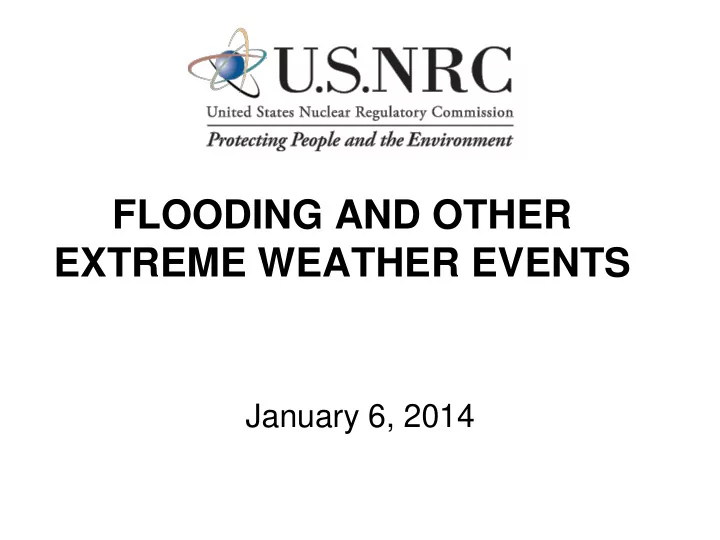

FLOODING AND OTHER EXTREME WEATHER EVENTS January 6, 2014 1
Licensing SAFETY Research Oversight 2
Flooding and Severe Storms Lessons Learned George Wilson, Flooding Lead Japan Lessons Learned Directorate Office of Nuclear Reactor Regulation 3
Overview • Reactor Oversight Process • Impacts of Plant Findings and Events • Oconee • Fort Calhoun • Watts Bar • Oyster Creek • Fukushima 4
Reactor Oversight • Specific inspection activities for adverse weather and flooding • Inspectors have identified flooding and severe weather issues • Feedback into regulatory process 5
Oconee Inadequate maintenance procedure led to developing Generic Issue 204, “Upstream Dam Failures” 6
Fort Calhoun Inadequate flood strategy provided insights for Near-Term Task Force (NTTF) Recommendation 2.3, “Flooding Walkdown,” guidance 7
Watts Bar Inspection findings at other sites resulted in greater focus on reasonable simulations at Watts Bar Nuclear Plant 8
Oyster Creek Effective contingency planning at Oyster Creek supported the site’s response to when Superstorm Sandy exceeded forecasts 9
Fukushima Importance of continued vigilance to ensure flood protection measures are adequate and maintained 10
Evolution of Flooding Hazards Christopher Cook, Chief Hydrology and Meteorology Branch Office of New Reactors 11
Overview • Evolution of Design Basis Flooding Hazards • Post-Licensing External Hazard Reevaluations • Present-Day Methods • Motivation for New Guidance • Continuing Evolution 12
Evolution of Design Basis Flooding Hazards • Hazard mechanisms considered today have not changed from those considered when licensing the operating fleet storm surge dam failure tsunami seiche power plant other river hazards flooding 13
Evolution of Design Basis Flooding Hazards (cont.) • What has changed? o Increased data record o Understanding of flooding hazards o Advancements in scientific knowledge and analytical tools 14
Post-Licensing External Hazard Reevaluations • Past and present external hazard reevaluations: o Systematic Evaluation Program (1977) o Individual Plant Evaluation for External Events (1991) o NTTF Recommendation 2.1 (2012) 15
Present-Day Methods for Estimating Design Basis Flooding Hazards • Based on the historical record for the site and region • Includes changes to the baseline data (climate change, construction of dams, etc.) • Predominantly deterministic • Hybrid deterministic-probabilistic approaches have been submitted for some hazards 16
Motivation for New Guidance • Flooding Hazards due to Dam Failure o Regulatory reviews demonstrated the need to update and supplement guidance • Flooding from Tsunami, Storm Surge, or Seiche o Incorporate lessons-learned from new reactor reviews and NRC research programs • Integrated Assessment for Flooding o Evaluate total plant response (protection and mitigation) to the reevaluated flooding hazard 17
Continuing Evolution • Evolving understanding of flooding hazards o Increasing data records o Improving scientific knowledge and analytical tools • Development of probabilistic methods • Periodic updates of flood hazard evaluations o NTTF Recommendation 2.2 18
Research Activities William Ott, Chief Environmental Transport Branch Office of Nuclear Regulatory Research 19
Overview • Regulatory guidance and supporting technical bases • Probabilistic flood hazard assessment (PFHA) • Considering Climate Change • Conclusion 20
Updating Regulatory Guidance • Regulatory Guide 1.59 “Design Basis Floods for Nuclear Power Plants” o Issue: Substantial improvement in technology (storm data, computational resources, models) o Five published technical reports o Draft regulatory guide nearing release 21
Updating Regulatory Guidance (cont.) • Regulatory Guide 1.102 “Flood Protection for Nuclear Power Plants” o Issue: Lessons learned from domestic and international experience o Technical basis project – final report under review o Draft revision to regulatory guide under development 22
Research to Improve Analyses • Transition from deterministic to more risk- informed framework o Probabilistic evaluation of riverine flooding o Extension of Probable Maximum Precipitation studies to include transposition and orographic features o Use of paleoflood data to inform flooding risks at nuclear power plants o Evaluation of dam-breach scenarios o PFHA workshop – January 29-31, 2013 23
Probabilistic Flood Hazard Assessment Research Program Plan • Outgrowth of (1) new reactor reviews, (2) reactor oversight program needs, (3) PFHA workshop • Technical Advisory Group on Flooding • Draft plan developed and under review • Includes collaboration with domestic and international experts 24
Considering Climate Change • Monitor scientific progress • General guidance in the revision to Regulatory Guide 1.59 o Site specific estimates based on federal projections from climate models o Projections for the life of the plant • Changes in variability of Great Lakes water levels 25
Summary • Substantial work has been completed to support state-of-the-art regulatory guidance • New research is directed at providing critical information for probabilistic analyses • A research program plan will guide future activities • Advances in climate change science will be monitored and given appropriate consideration 26
Conclusion • Safety is a continual process • Our understanding and knowledge continues to evolve • Lessons learned will be incorporated into the reactor oversight process 27
Recommend
More recommend